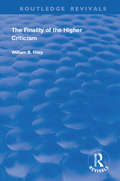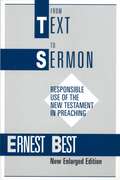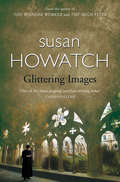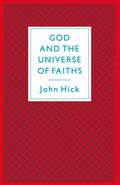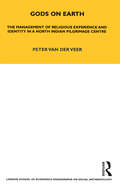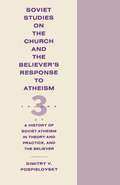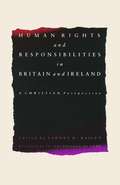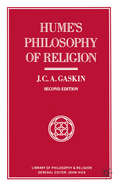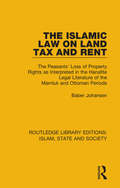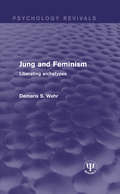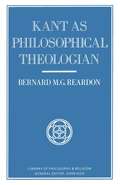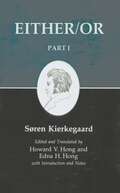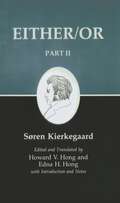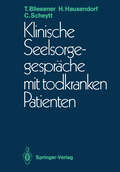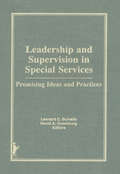- Table View
- List View
The Finality of the Higher Criticism: Or, The Theory of Evolultion and False Theology (Routledge Revivals)
by W. B. RileyFirst published in 1988, this volume was originally published, according to the authors, thanks to a ‘conscious call’. They were ‘fully persuaded that the honor of Christ and the very life of His church are alike endangered by the doubting spirit now brooding over the educational institutions of America.’ The book contains chapters on the prominence of scepticism in schools; the theory of evolution and false theology; and the sacred scriptures.
The Finality of the Higher Criticism: Or, The Theory of Evolultion and False Theology (Routledge Revivals)
by W. B. RileyFirst published in 1988, this volume was originally published, according to the authors, thanks to a ‘conscious call’. They were ‘fully persuaded that the honor of Christ and the very life of His church are alike endangered by the doubting spirit now brooding over the educational institutions of America.’ The book contains chapters on the prominence of scepticism in schools; the theory of evolution and false theology; and the sacred scriptures.
From Text to Sermon
by Ernest BestBest identifies the most common problems facing anyone who seeks to interpret the New Testament. He then shows how the preacher, teacher or ordinary reader can faithfully draw out the meaning of the New Testament.
The Ghost Festival in Medieval China
by Stephen F. TeiserLargely unstudied until now, the religious festivals that attracted Chinese people from all walks of life provide the most instructive examples of the interaction between Chinese forms of social life and the Indian tradition of Buddhism. Stephen Teiser examines one of the most important of such annual celebrations. He provides a comprehensive interpretation of the festivities of the seventh lunar month, in which laypeople presented offerings to Buddhist monks to gain salvation for their ancestors. Teiser uncovers a wide range of sources, many translated or analyzed for the first time in any language, to demonstrate how the symbolism, rituals, and mythology of the ghost festival pervaded the social landscape of medieval China.
Glittering Images: A Novel (Starbridge Ser. #1)
by Susan HowatchThe author’s most famous and well-loved work, the Starbridge series, six self-contained yet interconnected novels that explore the history of the Church of England through the 20th century.
Gods on Earth: The Management of Religious Experience and Identity in a North Indian Pilgrimage Centre (LSE Monographs on Social Anthropology)
by Peter van der VeerThis book is the result of the long interest in Hindu pilgrimage which was encouraged during his study of Sanskrit and Hinduism It provided a detailed historical anthropology of Ayodhya, which argues that religious values can reflect political and economic processes. This is Volume 59 of the London School of Economics Monographs on Social Anthropology.
Gods on Earth: The Management of Religious Experience and Identity in a North Indian Pilgrimage Centre (LSE Monographs on Social Anthropology)
by Peter van der VeerThis book is the result of the long interest in Hindu pilgrimage which was encouraged during his study of Sanskrit and Hinduism It provided a detailed historical anthropology of Ayodhya, which argues that religious values can reflect political and economic processes. This is Volume 59 of the London School of Economics Monographs on Social Anthropology.
The Hindu Temple: An Introduction to Its Meaning and Forms
by George MichellFor more than 1500 years, from the Indian subcontinent to the islands of the Indonesian archipelago, the temple has embodied and symbolized the Hindu worldview at its deepest level and inspired the greatest architectural and artistic achievements in Hindu Asia. In The Hindu Temple, considered the standard introduction to the subject, George Michell explains the cultural, religious, and architectural significance of the temple. He illustrates his points with a profusion of photographs, building plans, and drawings of architectural details, making the book a useful guide for travelers to Asia as well as an illuminating text for students of architecture, religion, and Asian civilizations. Michell's discussion of the meaning and forms of the temple in Hindu society encompasses the awe-inspiring rock-cut temples at Ellora and Elephanta, the soaring superstructures and extraordinary sexual exhibitionism of the sculptures at Khajuraho, and the colossal mortuary temple of Angkor Vat, as well as the tiny iconic shrines that many Hindus wear around their necks and the simple shrines found under trees or near ponds.
History Of Soviet Atheism In Theory And Practice And The Believer -: A History Of Soviet Atheism In Theory And Practice And The Believer (History Of Soviet Atheism In Theory And Practice, And The Believer Ser.)
by Dimitry V PospielovskyHuman Rights and Responsibilities in Britain and Ireland: A Christian Perspective
by Sydney D. BaileyHume’s Philosophy of Religion (Library of Philosophy and Religion)
by J.C.A. GaskinHume's Philosophy of Religion brings together for the first time the whole range of Hume's immensely important critique of religion. The major concern is with a clear discussion and presentation of philosophical issues wherever they occur in Hume's writings, but items in the history of ideas, questions of interpretation and biographical details are introduced when they contribute to an understanding of Hume's position. Already reviewed as a standard work on Hume on religion and as a good general introduction to Hume's thought, this new edition has been extensively revised and extended. '...it is hard to imagine how a study of Hume on religion could have been at once more comprehensive, accurate, readable and scholarly than this...it is strongly to be recommended to all who have occasion to study or to teach Hume in colleges or universities.' W.D.Hudson, Expository Times.
The Islamic Law on Land Tax and Rent: The Peasants' Loss of Property Rights as Interpreted in the Hanafite Legal Literature of the Mamluk and Ottoman Periods (Routledge Library Editions: Islam, State and Society)
by Baber JohansenThis book, first published in 1988, argues that a close inspection of the development of Hanafite law in the Mamluk and Ottoman periods reveals changes in legal doctrine which were not restricted to civil transactions but also concerned the public law. It focuses in particular on the interrelated areas of property, rent and taxation of arable lands, arguing that changes in the relationship between tax and rent led to a redefinition of the concept of landed property, a concept at the very heart of the Islamic legal system. This title will be of particular interest to students of Islamic history.
The Islamic Law on Land Tax and Rent: The Peasants' Loss of Property Rights as Interpreted in the Hanafite Legal Literature of the Mamluk and Ottoman Periods (Routledge Library Editions: Islam, State and Society)
by Baber JohansenThis book, first published in 1988, argues that a close inspection of the development of Hanafite law in the Mamluk and Ottoman periods reveals changes in legal doctrine which were not restricted to civil transactions but also concerned the public law. It focuses in particular on the interrelated areas of property, rent and taxation of arable lands, arguing that changes in the relationship between tax and rent led to a redefinition of the concept of landed property, a concept at the very heart of the Islamic legal system. This title will be of particular interest to students of Islamic history.
John Calvin's Perspectival Anthroplogy (American Academy Of Religion Academy Ser.)
by Mary Potter EngelJung and Feminism: Liberating Archetypes (Psychology Revivals)
by Demaris S. WehrJung, in contrast to Freud, has typically been considered more sympathetic to women largely because of his emphasis on the feminine as a way of being in the world and on the ‘anima’, the unconscious feminine aspect of male personality. Feminists, however, have viewed Jung’s whole notion of the ‘feminine’ with suspicion, seeing it as a projection of male psyche and not an authentic understanding of female humanity. For Demaris Wehr both feminism and Jungian psychology have been guiding forces, and in this book, originally published in 1988, she mediates between feminists and classical Jungians – two groups historically at odds. She faces squarely the male-centred assumptions of some Jungian concepts and challenges Jung’s claims for the universality and purely empirical basis of his work, but nevertheless maintains an appreciation for the value of Jung’s understanding of human nature and the process of individuation. By bringing the insights of feminist theology to bear on the seemingly unbridgeable gap between analytical psychology and feminism, she succeeds in reclaiming Jungian psychology as a freeing therapy for women and reveals it as the ultimately liberating vision its founder intended it to be.
Jung and Feminism: Liberating Archetypes (Psychology Revivals)
by Demaris S. WehrJung, in contrast to Freud, has typically been considered more sympathetic to women largely because of his emphasis on the feminine as a way of being in the world and on the ‘anima’, the unconscious feminine aspect of male personality. Feminists, however, have viewed Jung’s whole notion of the ‘feminine’ with suspicion, seeing it as a projection of male psyche and not an authentic understanding of female humanity. For Demaris Wehr both feminism and Jungian psychology have been guiding forces, and in this book, originally published in 1988, she mediates between feminists and classical Jungians – two groups historically at odds. She faces squarely the male-centred assumptions of some Jungian concepts and challenges Jung’s claims for the universality and purely empirical basis of his work, but nevertheless maintains an appreciation for the value of Jung’s understanding of human nature and the process of individuation. By bringing the insights of feminist theology to bear on the seemingly unbridgeable gap between analytical psychology and feminism, she succeeds in reclaiming Jungian psychology as a freeing therapy for women and reveals it as the ultimately liberating vision its founder intended it to be.
Kant as Philosophical Theologian (Library of Philosophy and Religion)
by Bernard M.G. ReardonThis book sets out to present Kant as a theological thinker. His critical philosophy was not only destructive of 'natural' theology, with its attempt to prove divine existence by logical argument, it also left no room for 'revelation' in the traditional sense. Yet Kant himself, who was brought up in Lutheran pietism, certainly believed in God, and could fairly be described as a religious man. But he held that religion can be based only on the moral consciousness, and in his last major work, Religion within the Limits of Reason Alone - discussed here in detail - he interpreted Christianity purely in terms of moral symbolism. It would be no exaggeration to claim that Kant's influence has been decisive for modern theology.
Kierkegaard's Writing, III, Part I: Either/Or
by Søren Kierkegaard Howard V. Hong Edna H. HongSøren Kierkegaard, the nineteenth-century Danish philosopher rediscovered in the twentieth century, is a major influence in contemporary philosophy, religion, and literature. He regarded Either/Or as the beginning of his authorship, although he had published two earlier works on Hans Christian Andersen and irony. The pseudonymous volumes of Either/Or are the writings of a young man (I) and of Judge William (II). The ironical young man's papers include a collection of sardonic aphorisms; essays on Mozart, modern drama, and boredom; and "The Seducer's Diary." The seeming miscellany is a reflective presentation of aspects of the "either," the esthetic view of life. Part II is an older friend's "or," the ethical life of integrated, authentic personhood, elaborated in discussions of personal becoming and of marriage. The resolution of the "either/or" is left to the reader, for there is no Part III until the appearance of Stages on Life's Way. The poetic-reflective creations of a master stylist and imaginative impersonator, the two men write in distinctive ways appropriate to their respective positions.
Kierkegaard's Writing, III, Part I: Either/Or
by Søren Kierkegaard Howard V. Hong Edna H. HongSøren Kierkegaard, the nineteenth-century Danish philosopher rediscovered in the twentieth century, is a major influence in contemporary philosophy, religion, and literature. He regarded Either/Or as the beginning of his authorship, although he had published two earlier works on Hans Christian Andersen and irony. The pseudonymous volumes of Either/Or are the writings of a young man (I) and of Judge William (II). The ironical young man's papers include a collection of sardonic aphorisms; essays on Mozart, modern drama, and boredom; and "The Seducer's Diary." The seeming miscellany is a reflective presentation of aspects of the "either," the esthetic view of life. Part II is an older friend's "or," the ethical life of integrated, authentic personhood, elaborated in discussions of personal becoming and of marriage. The resolution of the "either/or" is left to the reader, for there is no Part III until the appearance of Stages on Life's Way. The poetic-reflective creations of a master stylist and imaginative impersonator, the two men write in distinctive ways appropriate to their respective positions.
Kierkegaard's Writings IV, Part II: Either/Or
by Søren Kierkegaard Howard V. Hong Edna H. HongSøren Kierkegaard, the nineteenth-century Danish philosopher rediscovered in the twentieth century, is a major influence in contemporary philosophy, religion, and literature. He regarded Either/Or as the beginning of his authorship, although he had published two earlier works on Hans Christian Andersen and irony. The pseudonymous volumes of Either/Or are the writings of a young man (I) and of Judge William (II). The ironical young man's papers include a collection of sardonic aphorisms; essays on Mozart, modern drama, and boredom; and "The Seducer's Diary." The seeming miscellany is a reflective presentation of aspects of the "either," the esthetic view of life. Part II is an older friend's "or," the ethical life of integrated, authentic personhood, elaborated in discussions of personal becoming and of marriage. The resolution of the "either/or" is left to the reader, for there is no Part III until the appearance of Stages on Life's Way. The poetic-reflective creations of a master stylist and imaginative impersonator, the two men write in distinctive ways appropriate to their respective positions.
Kierkegaard's Writings IV, Part II: Either/Or
by Søren Kierkegaard Howard V. Hong Edna H. HongSøren Kierkegaard, the nineteenth-century Danish philosopher rediscovered in the twentieth century, is a major influence in contemporary philosophy, religion, and literature. He regarded Either/Or as the beginning of his authorship, although he had published two earlier works on Hans Christian Andersen and irony. The pseudonymous volumes of Either/Or are the writings of a young man (I) and of Judge William (II). The ironical young man's papers include a collection of sardonic aphorisms; essays on Mozart, modern drama, and boredom; and "The Seducer's Diary." The seeming miscellany is a reflective presentation of aspects of the "either," the esthetic view of life. Part II is an older friend's "or," the ethical life of integrated, authentic personhood, elaborated in discussions of personal becoming and of marriage. The resolution of the "either/or" is left to the reader, for there is no Part III until the appearance of Stages on Life's Way. The poetic-reflective creations of a master stylist and imaginative impersonator, the two men write in distinctive ways appropriate to their respective positions.
Klinische Seelsorgegespräche mit todkranken Patienten
by Thomas Bliesener Heiko Hausendorf Christoph ScheyttIn einer Zeit, in der die Frage des Umgangs mit todkranken Menschen zunehmend an Bedeutung gewinnt, bringt dieses Buch entscheidende Hinweise und neue Ansätze für den Bereich der Klinikseelsorge. Das Gespräch zwischen Klinikseelsorger und Patienten wird hier erstmals unter gesprächsanalytischen und institutionsspezifischen Gesichtspunkten untersucht. Dabei wird Klinikseelsorge als eigenständiges Forschungsfeld mit unmittelbar umsetzbaren Konsequenzen für den Alltag dargestellt. Aus Analysen von Seelsorgegesprächen mit todkranken und sterbenden Menschen werden für diesen hochsensiblen Bereich klare Empfehlungen für eine nicht-direktive Gesprächsführung abgeleitet. Dabei wird sowohl nach dem Sinn und der Berechtigung als auch nach der Qualität der Seelsorgegespräche mit todkranken Patienten gefragt und der Berührungspunkt zwischen theologischer Reflexion und Gesprächsanalyse aufgezeigt.
Leadership and Supervision in Special Services: Promising Ideas and Practices
by Charles A Maher David E Greenburg Leonard BurrelloHere is an authoritative reference on a range of subjects vital to supervisory personnel whose responsibilities include children with learning and/or behavior problems. Leading professionals - serving as members of a special writing team of the Council of Administrators of Special Education (CASE) - offer a rich source of ideas especially for administrative personnel involved in the delivery of special educational programs and services to children with handicapping conditions. Chapters cover such topics as critical success factors, supervision and evaluation, cost analysis, and more.
Leadership and Supervision in Special Services: Promising Ideas and Practices
by Charles A Maher David E Greenburg Leonard BurrelloHere is an authoritative reference on a range of subjects vital to supervisory personnel whose responsibilities include children with learning and/or behavior problems. Leading professionals - serving as members of a special writing team of the Council of Administrators of Special Education (CASE) - offer a rich source of ideas especially for administrative personnel involved in the delivery of special educational programs and services to children with handicapping conditions. Chapters cover such topics as critical success factors, supervision and evaluation, cost analysis, and more.
